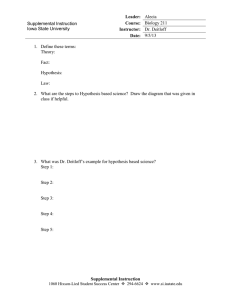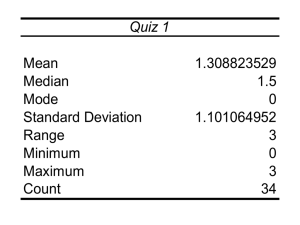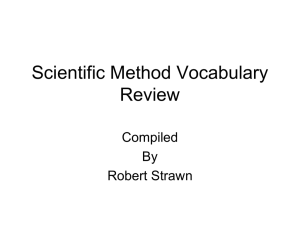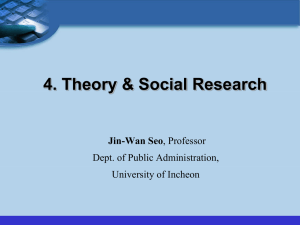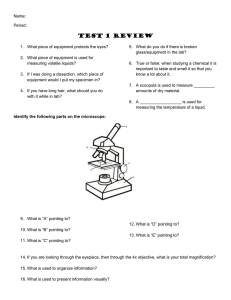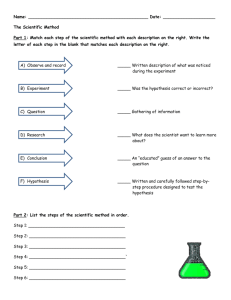Definitions of Science: Laws, Theories, and Technology
advertisement
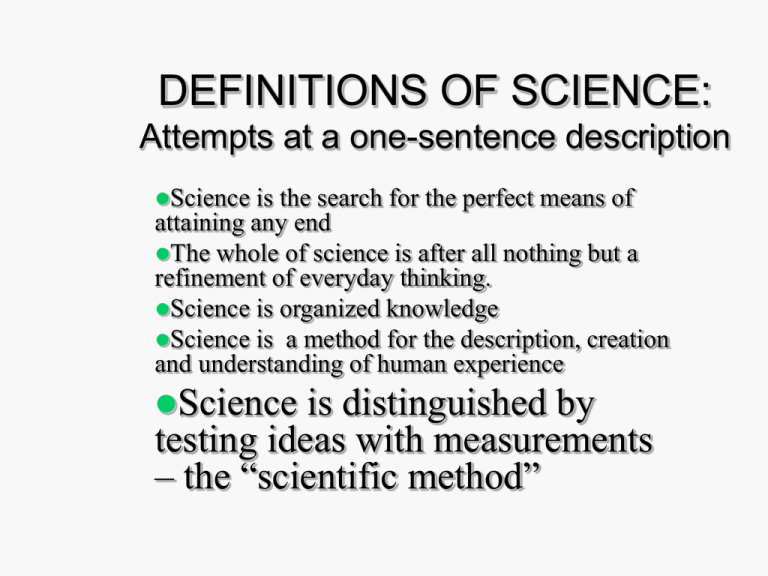
DEFINITIONS OF SCIENCE: Attempts at a one-sentence description Science is the search for the perfect means of attaining any end The whole of science is after all nothing but a refinement of everyday thinking. Science is organized knowledge Science is a method for the description, creation and understanding of human experience Science is distinguished by testing ideas with measurements – the “scientific method” The character of science Science is a social enterprise o “I am among those who think that science has a great beauty. We should not allow it to be believed that all scientific progress can be reduced to mechanisms, machines, gearings, even though such machinery also has its own beauty.” Marie Curie Ignorance of science American high school students perform worse than 21 other countries Spending on research declines Fewer scientists are produced 50 % of the population dismiss evolutionary biology in favour of a “special” creation Fear of science and embracing “magic” Scientific developments under siege o Useful applications of nuclear power o Stem cell research o Genetic engineering of crops The book “Natural Cures ‘They’ Don’t Want You to Know About” was a top ten seller for more than a year Attitudes of the scientist Curiosity Open mind Interest in knowledge Courage of convictions Capability of abandoning beliefs in the light of new knowledge Skeptical Critical Tools of the trade Ways of dealing with information and thinking scientifically: Laws and Theories HYPOTHESIS: an educated guess derived from various assumptions which can be tested using a range of methods; a proposition put forward for proof or discussion LAW A rule which describes specified natural phenomena within the limits of experimental observation (LDST) Ohm’s Law, Gravity, Boyle’s Law… Scientific laws are precise, can be reduced to mathematical expressions Laws have limited regions of application - don't always work in all situations Laws do not provide understanding of why things happen Laws cannot be extrapolated THEORY Confirmed explanation of phenomena; a hypothesis tested and confirmed with facts (scientific evidence) not previously known (CCTD) A scheme or system of ideas or statements held as an explanation or account of a group of facts or phenomena; a hypothesis that has been confirmed or established by observation or experiment, and is accepted as accounting for the known facts (OED) Features of theories Is a theory ever true? o Difficult to say that a theory is true after some predictions are o o o o proved, because further predictions may be untrue. New results may falsify the theory. Theory of relativity demonstrated limitations in Newtonian mechanics. Relativity is being challenged by new results. Theories tend to be modified to improve their performance. Theories have predictive power o Prediction of existence of subatomic particles from quantum theory Theories provide understanding of why things happen Law and Theory contrasted using gases Boyle’s Law (17th century) o Experimental observation of relationship between pressure and volume of a gas Kinetic theory of gases (19th century) o Mathematical derivation of observed gas law using postulate that a gas consists of molecules which can be treated like small hard spheres in random motion. The behaviour of the gas is predicted using known mechanics of spheres Scientific “method” Observation vs imagination Imagination plays an increasingly important role in science. Inductive approach relies wholly on observation to develop a theory (“And God forbid we should offer the dreams of fancy for a model of the world”) Newton offered: “…hypotheses ... have no place in experimental philosophy.” Deductive relies on imagination. More important today. Hypothesis may originate purely in the realm of the imagination, using also some known mathematical relations. Kekule’s dream about the structure of benzene Technology Technology is human activity directed toward satisfaction of human needs by more effective use of environment Technology is obtaining a better living from resources making gadgets and tools Technology is not a contemplative activity, except where it is used in the design of new things; the pondering is directed towards a specific practical goal, not contemplation for its own sake Technology also gives rise to science as its tools and things are invented Technology is older than science: early man made a club to get food, not because it seemed like an interesting thing to do RELATIONS BETWEEN SCIENCE AND TECHNOLOGY The relationship between science and technology in history has not always been clear, and it has not been easy to say which influenced which. STEAM ENGINE DEVELOPMENT: Science had nothing to do with the invention of the steam engine; no theory was apparently employed in its development. In fact, science benefited from its invention. On the other hand, the process for perfecting the steam engine was not made by engineers/technologists but by a basic scientist (Carnot). His work on heat flow was foundational to thermodynamics. Thus: technology developed a steam engine, which lead to scientific thought and discovery of new scientific relationships thermodynamics. Research and Technology Electromagnetism is an opposite example. Faraday was a scientist who demonstrated that magnetism generated electricity. This led to development of electrical supply industry and electrical generation, in which, Faraday had no significant part. It had further consequences for science and technology. (Edison) There is a relation between basic research and the ability to develop new technology; from basic research comes unpredictable and unknown information that enable new things; magnetic domains from the study of magnetism for example, which resulted in new magnetic materials. TENSION BETWEEN BENEFITS AND COSTS – Risks and rewards Technology has meant a vast increase in the production and consumption of energy. Technology has enabled massive growth in population: greater competition for resources. Technology has brought benefits and problems. Solutions to problems depend on greater investment in technology, not a reversal of the process.
